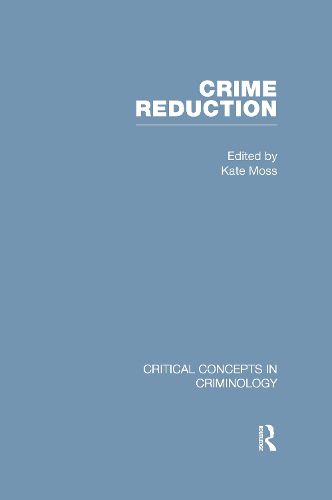Crime Reduction

Crime Reduction
Across the globe, challenging and contentious issues about community safety and security increasingly exercise governments and police forces–as well as, for example, town planners and car-park designers. Consequently, as a specialist area within the wider discipline of criminology, crime reduction has never before enjoyed such prominence in public and scholarly discourse. With research on and around the subject flourishing as never before, this new title in the Routledge Major Works series, Critical Concepts in Criminology, meets the need for an authoritative reference work to make sense of the subdiscipline’s colossal literature and the continuing explosion in research output and practice. Edited by Kate Moss, a prominent academic in the field, Crime Reduction is a four-volume collection of foundational and cutting-edge scholarship. The first volume in the collection (‘Approaches to Reduction’) brings together the best research on the different approaches to crime reduction, including its classification and theory, and ideas of what is preventable.The work gathered here also includes criticisms of crime reduction, not least research around the phenomena of displacement and sustainability. Volume II (‘Motivation of the Criminal Inclination’) collects the most important work on issues of crime reduction, particularly those concerned with what one thinker has described as ‘structure and psyche’. The scholarship in this volume draws both on the structural perspective (which emphasizes the view that reduction is achievable only through economic and social change, especially by ameliorating inequality or levels of social exclusion), and the ‘psyche’ approach (which regards crime principally as a product of the human spirit and seeks to change criminal inclination and activity by policies of, for example, deterrence, incapacitation, and reform). The notion of situational crime reduction has been a particularly active area of research in recent years. But the idea that changes to the social and physical settings in which crime may occur can reduce its frequency or impact is far from uncontroversial.Volume III (‘Situational Crime Reduction’) assembles the best thinking in this area tackling, for example, ethical dilemmas about the impact of some reduction strategies on our freedom and privacy rights, as well as the difficult and profound implications that arise from the increasing extent to which crime reduction has become the de facto responsibility of private rather than state organizations. The final volume in the collection (‘Crime Prevention in Action’) gathers together the best cutting-edge work to highlight key examples of empirical crime reduction research in action. It includes research focusing on: the need to incentivize crime reduction to persuade more people to take responsibility for reducing a greater variety of crime; the effects of apparently subtle strategies (such as changes to street lighting); and anticipatory changes (whereby crime seems to reduce in advance of reduction initiatives). Volume IV also includes assessments of the future developments in the field. Crime Reduction is fully indexed and includes a comprehensive introduction, newly written by the editor, which places the collected material in its historical and intellectual context.An essential reference collection, it is destined to be valued by scholars, students, and practitioners as a vital one-stop research and pedagogic resource.
This item is not currently in-stock. It can be ordered online and is expected to ship in approx 4 weeks
Our stock data is updated periodically, and availability may change throughout the day for in-demand items. Please call the relevant shop for the most current stock information. Prices are subject to change without notice.
Sign in or become a Readings Member to add this title to a wishlist.


